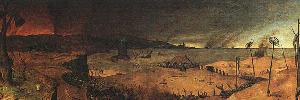Exploring
|
 |
Exploring
|
 |
The traditional reading of The Waste Land after it was first published in 1922 was that it was commenting on the post-war (WW I) social order. Since 1968, when draft of The Waste Land was made public (it was long thought lost), the interpretations have been increasingly leaning toward Eliot's having put autobiographical elements into the poem.
When I first studied The Waste Land I had the good fortune to come across the book T. S. Eliot's Personal Waste Land by James E. Miller Jr. In his study, Miller elaborated upon two essays by John Peter and using the drafts of The Waste Land presented a case for a very personal meaning for the poem. This type of an autobiographical reading of the poem still causes controversy and Peter's and Miller's interpretations in particular. Still, I found Miller's case reasonable and illuminating. By my viewing the poem in his light The Waste Land became a work of art instead of a mass of confusion.
A word of caution -- my commentary derives from Miller's presentation of a personal meaning to The Waste Land but please view it as my own work. I have my own ideas on various aspects of the poem and would not want Miller's professional reputation to suffer from this amateur's commentary. Besides, I could not come close to matching Miller's clarity of writing and thinking. Taking my words as his would be doing him a terrible disservice. Instead I highly recommend that you find a copy of T. S. Eliot's Personal Waste Land. Unfortunately it is now out of print. Try libraries, second-hand book stores or use internet second-hand book shops.
For the most part, to allow visitors to interpret The Waste Land for themselves, my commentary has been kept to sections clearly marked as commentary. Other sections such as my additions to Eliot's notes, definitions, translations and links to works that Eliot alludes to in the poem will still be useful to those who prefer other readings or want to create their own.
To home page of Exploring The Waste Land